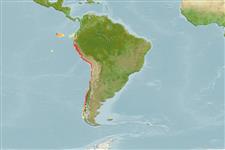Classification / Names
Nombres comunes | Sinónimos | Catalog of Fishes(Género, Especie) | ITIS | CoL | WoRMS | Cloffa
>
Lophiiformes (Anglerfishes) >
Oneirodidae (Dreamers)
Etymology: Chaenophryne: Greek, 'chaeno' or 'chaino' = to gape + Greek, 'phryne' = toad (alluring to a "gaping toad") (Ref. 86949); quasiramifera: Name from Latin 'quasi' meaning simulating or appearing 'as if', and 'ramifera', refes to the similarity of its esca to its congener C. ramifera..
Environment: milieu / climate zone / depth range / distribution range
Ecología
marino batidemersal; rango de profundidad 0 - 1130 m (Ref. 75756). Deep-water
Southeast Pacific: Peru-Chile Trench and Nasca Ridge.
Tamaño / Peso / Age
Maturity: Lm ? range ? - ? cm
Max length : 9.8 cm SL macho / no sexado; (Ref. 75756)
Short description
Morfología | Morfometría
Radios blandos dorsales (total): 8; Radios blandos anales: 6. This species can be easily distinguished from its congeners in having the following characters: 1 or 2 elongate illicial filaments originating laterally just below base of escal bulb (vs. C. ramifera with 7-12 on each side; descending escal appendage extending along anterior margin of illicium, a small proximal portion emerging at articulation of illicium and illicial pterygiophores as a free, anterodorsally directed tentacle; short illicium, 21.1-22.9% SL; greater number of dorsal- and anal-fin rays, 8 and 6, respectively (Ref. 75756).
Life cycle and mating behavior
Madurez | Reproducción | Puesta | Huevos | Fecundidad | Larva
Pietsch, T.W., 2007. A new species of the ceratioid anglerfish genus Chaenophryne Regan (Lophiiformes: Oneirodidae) from the Eastern Tropical Pacific Ocean. Copeia 2007(1):163-168. (Ref. 75756)
IUCN Red List Status (Ref. 130435)
Threat to humans
Harmless
Human uses
Más información
Nombres comunesSinónimosMetabolismoDespredadoresEcotoxicologíaReproducciónMadurezPuestaAgregación para la puestaFecundidadHuevosEgg development
Age/SizeCrecimientoLength-weightLength-lengthLength-frequenciesMorfometríaMorfologíaLarvaDinámica larvariaReclutamientoAbundanciaBRUVS
ReferenciasAcuiculturaPerfil de acuiculturaRazasGenéticaElectrophoresesheritabilidadEnfermedadesProcesamientoNutrientsMass conversion
ColaboradoresImágenesStamps, Coins Misc.SonidosCiguateraVelocidadTipo de nataciónSuperficie branquialOtolitosCerebrosVisión
Herramientas
Special reports
Download XML
Fuentes de Internet
Estimates based on models
Preferred temperature (Ref.
123201): 7.6 - 13.3, mean 9.7 °C (based on 38 cells).
Phylogenetic diversity index (Ref.
82804): PD
50 = 0.5312 [Uniqueness, from 0.5 = low to 2.0 = high].
Bayesian length-weight: a=0.01995 (0.00906 - 0.04395), b=3.01 (2.83 - 3.19), in cm total length, based on all LWR estimates for this body shape (Ref.
93245).
Nivel trófico (Ref.
69278): 3.7 ±0.5 se; based on size and trophs of closest relatives
Resiliencia (Ref.
120179): Alto, población duplicada en un tiempo mínimo inferior a 15 meses (Preliminary K or Fecundity.).
Fishing Vulnerability (Ref.
59153): Low vulnerability (10 of 100).
